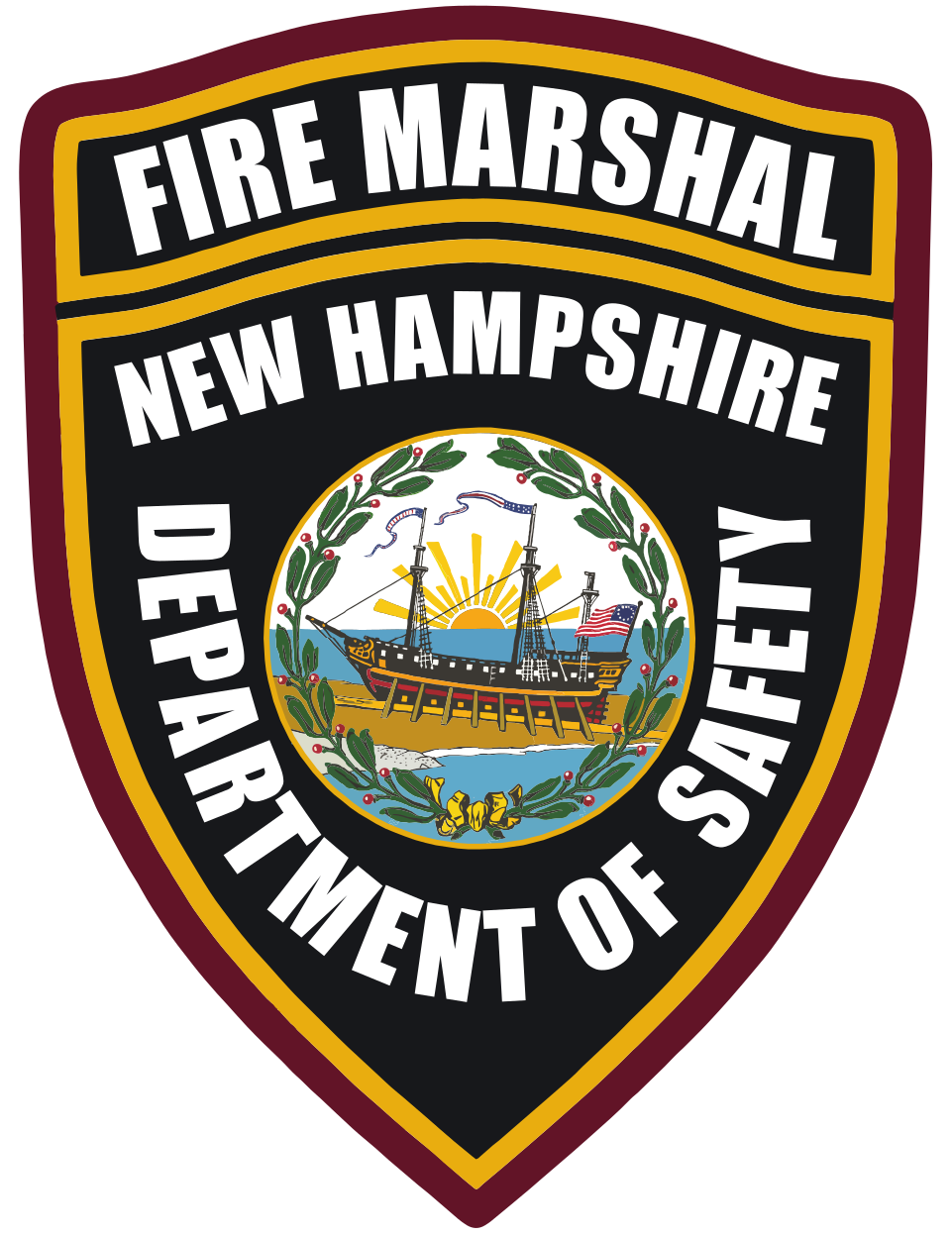Incident Reporting FAQs
Find answers to commonly asked questions related to New Hampshire’s Fire Incident Reporting System (NHFIRS).
When a fire department is involved in some type of community service (parade patrol) and personnel/equipment are being used, what code best reflects what they are doing?
The code that bests reflects the activity in this case is “553 - Public service. Excludes service to governmental agencies (551 or 552)"
A fire department responds to a vehicle fire on the highway and then had a couple of other fires down the road caused by the same vehicle as it drove further down the highway. Is that an exposure to the first fire, or separate fires, separate incidents?
The additional fires should be classified as exposure fires.
I have departments that are plus-one coding their incidents to death. How can a department further define their actions taken without using a plus-one code on the actual action taken code? For example, a fire department responds to an EMS call (Incident type 321). The action taken is to provide ALS. They want to capture the fact that their medic went with the ambulance to the hospital. Is it possible that they can capture this information by using the apparatus/personnel module instead of using a plus-one code?
The current system does not have a method to capture the fact that their medic went with the ambulance to the hospital.
An apparatus arrives at the scene but is canceled before personnel exit the vehicle. How should this be coded?
The incident should still be coded as a "611 - Dispatched and canceled en route. Incident cleared or canceled prior to arrival of the responding unit. If a unit arrives on the scene, fill out the applicable code."
How would the location of moving vehicle fire be reported? Would it be the location when first reported, the location when found by the first arriving unit or the location when it stops?
The location documented should be location where the vehicle stopped.
A department responded to a reported MVA at a specific location, found none at the location, but continued on and finally found the MVA at a different location. Should the location be reported as the initial address or the final address?
The location documented should be location where the vehicle was found.
Should an uncontained trash fire in a structure that only burns the trash be coded as an Incident Type #118 ("Trash or rubbish fire in a structure, with no flame damage to structure or its contents")? The other confined structure fire codes mention non-combustible containers, but this code does not. If Incident Type #118 cannot be used, isn't Incident Type #111 the default which requires both the Fire and Structure Fire Module?
The appropriate Incident Type in this case would be "118 - Trash or rubbish fire in a structure, with no flame damage to structure or its contents."
How would an incident involving smoke from a chimney misidentified as a hostile fire be reported? Incident Type #653 seems too specific: "Smoke from barbecue or tar kettle (no hostile fire)."
The appropriate Incident Type in this case would be "651 - Smoke scare, odor of smoke, not steam (652). Excludes gas scares or odors of gas (671)."
Should a fire confined to a toaster, microwave oven, or conventional oven be coded as an Incident Type #113 or as an #111 or #121? Are these items considered cooking vessels or equipment involved? If coded as an Incident Type #113, the Equipment Involved in Ignition would not be captured because the Fire Module would not be completed but the cause would still be cooking.
The incident should be coded as a "111 - structure fire" and the equipment involved should be captured.
How would an accidental medical alarm be reported?
The most appropriate code in the case would be '740 - Unintentional transmission of alarm, other'. This Incident type was not specifically designed for this situation so the fire department may want to consider a plus one code to capture more specifics.
I heard that when an electric range was the heat source in an unattended cooking fire, the range should not be identified as the "Equipment Involved in Ignition" because it neither malfunctioned nor was misused. Isn't this incorrect? If the "Heat Source (Fire, D2)" is Operating Equipment (Codes 10 – 13), shouldn't "Equipment Involved in Ignition" always be identified? According to the Cause Category Methodology Matrix, if "Equipment Involved in Ignition" is not identified when "Heat Source" is Codes 10 – 13, the cause will be undetermined. Could systematically omitting the "Equipment Involved in Ignition" be the reason for so many undetermined fires?
Yes.
A fire department was called to a pipe bomb in a mailbox incident. The department did not remove or disarm the explosive, but called the police. How should this be coded?
The appropriate Incident Type in this case would be "552 - Police matter. Includes, incidents where FD is called to a scene that should be handled by the police."
According to the CRG, if a department fills-in for a nearby department and then responds to an incident while filling in, the responding department should only fill out an incident report using the receiving departments FDID and incident number and report Aid Given/Received as None because once the giving department is in the receiving department's station it is the same as if they are the receiving department's personnel. The responding department should not fill out the incident as an Aid Given call using the responding departments' FDID and incident number. Basically, in that situation, the responding department disappears and is absorbed into the receiving department it is filling in for. However, if the responding department goes on an EMS call under those circumstances and leaves patient medical data with the receiving department to fill out the incident report, is this a HIPPA privacy violation?
HIPPA regulations in this case do not preclude the information from being collected although there are requirements for how the information should be safeguarded. Fire departments should get advice from their city attorney for specific guidance on how the information should be protected.
Is there a method of capturing "number evacuated", whether mandatory or voluntary, in NFIRS?
Number evacuated can be captured in the Haz-Mat Module, through special studies, or the information may be captured in the narrative.
Ever since day one, our ski resort classification seems to always be by default "other". Vacation and/or second, part time use, homes and condos do not seem to have a straight forward section either. Do you have any suggestions?
If the ski resort is a hotel it should be coded as such. The same is true for a single family home whether it is used for a year-round residence or a vacation home.
Since Fire Department A EMS is not connected to the Fire Department A, is this considered a private Ambulance Service? If so, in the case of a motor vehicle accident with the Fire Department assisting EMS, what should the code be – a 311 or a 551 or is it 324 (EMS Incident)? For clarification – the EMS is sometimes called along with Fire Department A in case there are injuries.
The appropriate Incident Type in this case would be "311 - Medical assist. Includes incidents where medical assistance is provided to another group/ agency that has primary EMS responsibility. (Example, providing assistance to another agency-assisting EMS with moving a heavy patient.)" Incident Type 324 would be used if the department was responding in an EMS capacity.
For an incident where an electrical transformer (pole mounted or ground mounted) is burning, what Incident Type Code do you recommend?
The appropriate Incident Type in this case would be "112 – Fire in structure, other than in a building. Included are fires on or in piers, quays, or pilings: tunnels or underground connecting structures; bridges, trestles, or overhead elevated structures; transformers, power or utility vaults or equipment; fences; and tents."
How should Methamphetamine lab fires be coded?
Assuming that the lab fire is in a single–family home:
- Basic Module
- Incident Type =111 (building)
- Property Use = 419 (1 or 2 family dwelling)
- Fire Module
- On-Site Materials = 545 (illegal drugs)
- On-Site Materials Use = 2 (processing or manufacturing)
- Fire Suppression Factor = 222 (illegal and clandestine drug operation)
If, in addition to the above, you wanted to specifically capture that the on-site illegal drug was methamphetamine, you could create a state level 'plus one' code for code 545 (for example: '5451 Methamphetamine').
The contents of the other critical cause and ignition fields would, of course, be dependent of the specifics of what happened in each individual fire.
What is the difference between Incident Types 736 and 746? When would it be the appropriate times to use each? The clause "no carbon monoxide detected" in 746 is confusing. If none was detected, how does one know if it was a malfunction or unintentional?
Incident Type 736 is a carbon monoxide detector activation caused by a malfunction of the detector. Incident Type 746 is used when there is an accidental; or manual activation of a detector that is not caused by a malfunctioning detector.
What is a good definition of "Actions Taken" (Basic, F) code 92, Standby? Could this be used for personnel waiting in a staging area?
This is any time department personnel have been dispatched but instead of responding, are standing by for deployment. Yes, it can be used for personnel waiting in a staging area.
Is the death of a firefighter from a heart attack that was suffered 48 hours after responding to an incident considered to be related to that incident?
No. The limit under the Hometown Heroes Act, which is the guideline used by USFA, is 24 hours.
What incident type should be used for a mulch fire?
The appropriate Incident Type in this case would be "160 - Special outside fire, other."
Someone threw fireworks into the house that self extinguished and the fire department had only light smoke to deal with. There were 4-5 burn marks on the floor of the kitchen. On the investigation end, this will be considered ARSON but should the incident be coded as a structure fire? The fire department coded it as smoke scare, odor of smoke. What should this incident be coded as?
This should be coded as a non-fire. Specifically, it should be Incident Type "481 (Attempt to burn)."
Field H3 on the Basic Module, selection "1 – Natural gas, slow leak, no evacuation or Hazmat Actions taken." – If the dept asks a resident to step outside of the structure while it is being investigated, is that evacuation? What is the meaning of evacuation? We respond to this type of call often but do not conduct large scale evacuation and this code is causing some confusion when reporting it. Example would be a slow leak from a kitchen stove and the CO Detector has activated.
Yes. The definition of evacuation is the movement of persons from a dangerous place due to a dangerous situation.



